
The Mesa Arizona Temple is the seventh operating temple of the Church of Jesus Christ of Latter-day Saints. The intent to build the temple was announced on October 1, 1919, by church president Heber J. Grant, during the church's general conference. Located in the city of Mesa, Arizona, as of April 2024, it is the first of the church's seven temples built or planned in the state, with three of those in Maricopa County. A groundbreaking ceremony was held on April 25, 1922, and the dedication, conducted by Grant, was on October 23, 1927.

The St. George Utah Temple, formerly known as the St. George Temple, is a temple of the Church of Jesus Christ of Latter-day Saints in St. George, Utah. Completed in 1877, it was the third temple constructed by the church and the first in Utah, following the westward migration of members from Nauvoo, Illinois, after the death of church founder Joseph Smith.
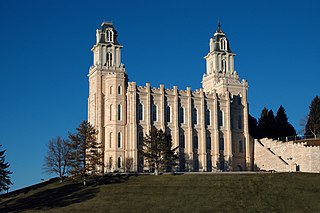
The Manti Utah Temple is the fifth constructed temple of the Church of Jesus Christ of Latter-day Saints. Located in the city of Manti, Utah, it was the third Latter-day Saint temple built west of the Mississippi River, after the Mormon pioneers trekked west. The Manti Temple was designed by William Harrison Folsom, who moved to Manti while the temple was under construction. The temple dominates the Sanpete Valley and can be seen from many miles. Like all Latter-day Saint temples, only church members in good standing may enter. It was previously one of only two remaining Latter-day Saint temples in the world where live portrayal was used in the endowment ceremony. All other temples use a film in the presentation of the endowment, a practice that will also be used in Manti beginning in 2024 following renovation. It is an early pioneering example of four rooms representing the journey of life.

The Cardston Alberta Temple is a temple of the Church of Jesus Christ of Latter-day Saints in Cardston, Alberta. It was the eighth temple constructed and is the sixth still in operation. The intent to build the temple was announced on October 12, 1912, by church president Joseph F. Smith, during the church's general conference. It was both the first temple built in Canada and outside the United States. There are four temples in the province of Alberta and ten operated by the church in Canada.
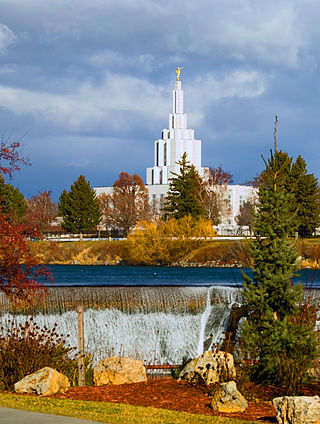
The Idaho Falls Idaho Temple is a temple of the Church of Jesus Christ of Latter-day Saints in Idaho Falls, Idaho. The intent to build the temple was announced on March 3, 1937, by church president Heber J. Grant during the church's general conference. It is the church's tenth constructed and eighth operating temple, the first built in Idaho, and the first built with a modern single-spire design.

The Hamilton New Zealand Temple is the 13th constructed and 11th operating temple of the Church of Jesus Christ of Latter-day Saints. The intent to build the temple was announced on February 17, 1955, by church president David O. McKay during a meeting of the First Presidency and Quorum of the Twelve Apostles. With its completion in 1958, it was the church's first temple in the Southern Hemisphere, the second built both in Polynesia and outside the United States and Canada, after the Laie Hawaii Temple. Located just outside Temple View in Hamilton, it was built with a modern single-spire design similar to the Bern Switzerland Temple. As of May 2024, this is the only temple currently operating in New Zealand, with one in Auckland under construction, and another in Wellington in the planning phase.

The Oakland California Temple is a temple of the Church of Jesus Christ of Latter-day Saints in Oakland, California. Notable for its five-spire design influenced by Asian architecture, the temple stands on a hill with panoramic views of the San Francisco Bay Area. The complex, sometimes referred to as Temple Hill, includes a visitors' center, a church employment center, a materials distribution center, an auditorium, an inter-stake center, a rooftop terrace, and gardens where photoshoots for quinceañeras and other celebrations take place.

The Provo Utah Temple was a temple of the Church of Jesus Christ of Latter-day Saints located in Provo, Utah, just north of Brigham Young University (BYU). The intent to build the temple was announced on August 14, 1967, by Hugh B. Brown and N. Eldon Tanner. The church's temples are a sacred space where church members make covenants and perform ordinances for themselves and their deceased ancestors. The temple was designed by architect Emil B. Fetzer and was dedicated in 1972 as the church's seventeenth constructed and fifteenth operating temple. It was the sixth temple built in Utah, and the first in both Utah County and Provo.

The Ogden Utah Temple is the sixteenth constructed and fourteenth operating temple of the Church of Jesus Christ of Latter-day Saints. Located in Ogden, Utah, it was originally built with a modern, single-spire design very similar to the Provo Utah Temple. During a renovation completed in 2014, the exterior and interior were extensively changed.
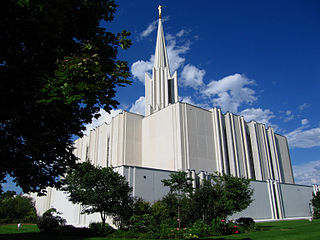
The Jordan River Utah Temple is the 20th operating temple of the Church of Jesus Christ of Latter-day Saints, located in South Jordan, Utah. The intent to build the temple was announced on February 3, 1978, by church president Spencer W. Kimball during a press conference in the Church Office Building. The temple is the first in the city of South Jordan, the fifth in Salt Lake County, and as of 2024 is one of twenty-eight in the state of Utah.
The Apia Samoa Temple is the 24th constructed and 22nd operating temple of the Church of Jesus Christ of Latter-day Saints. It was the first built in Samoa and the third to be built in Polynesia. After it was destroyed by fire, a new temple was built and dedicated on the same grounds.

The Portland Oregon Temple is a temple of the Church of Jesus Christ of Latter-day Saints located on 7 acres (28,000 m2) of land near the intersection of Highway 217 and I-5 in Lake Oswego, Oregon. The intent to build the temple was announced on April 7, 1984 by church president Spencer W. Kimball, during the church's general conference. Dedicated in 1989, the Portland Oregon Temple was the church's first temple in Oregon and the 42nd in the church. Prior to its dedication by Gordon B. Hinckley, over 314,000 people attended the public open house.
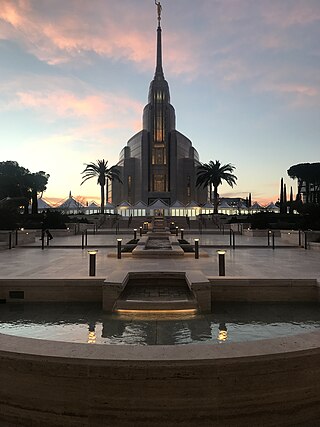
The Rome Italy Temple is a temple of the Church of Jesus Christ of Latter-day Saints in Rome, Italy. The temple serves church members in Italy, as well as Malta, Greece, Cyprus, Albania, and parts of Romania. Thomas S. Monson, the LDS Church's president, initially announced the temple in 2008, a groundbreaking took place in 2010, and the temple opened after its dedication in 2019.

The Church of Jesus Christ of Latter-day Saints in Utah refers to the Church of Jesus Christ of Latter-day Saints and its members in Utah. Utah has more church members than any other U.S. state or country. The LDS Church is also the largest denomination in Utah.
The Urdaneta Philippines Temple is temple of the Church of Jesus Christ of Latter-day Saints in Urdaneta City, Pangasinan, Philippines. The intent to build the temple was announced on October 2, 2010, by then church president Thomas S. Monson, during the church's general conference. The temple is the third in the Philippines, following those in Manila and Cebu City.

The Layton Utah Temple is a temple of the Church of Jesus Christ of Latter-day Saints under construction in Layton, Utah. The intent to construct the temple was announced by church president Russell M. Nelson on April 1, 2018, during the 188th general conference. The Layton Utah Temple was announced concurrently with 6 other temples. At the time, the number of total operating or announced temples was 189. It is the 22nd temple in Utah and the second temple in Davis County.

The Orem Utah Temple is a temple of the Church of Jesus Christ of Latter-day Saints located in Orem, Utah. The intent to build the temple was announced on October 5, 2019, by church president Russell M. Nelson, during the church's general conference. The temple is the first in the city of Orem, the sixth in Utah County, and the 28th in the state of Utah.

The Taylorsville Utah Temple is a temple awaiting dedication of the Church of Jesus Christ of Latter-day Saints in Taylorsville, Utah. Plans to construct the temple were announced on October 5, 2019 by church president Russell M. Nelson, during the church's general conference. The temple is the first in the city of Taylorsville, the fifth in Salt Lake County, and the twenty-third in the state of Utah.
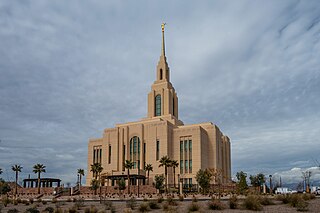
The Red Cliffs Utah Temple, originally announced as the Washington County Utah Temple, is a temple of the Church of Jesus Christ of Latter-day Saints in St. George, Utah. The intent to construct the temple was announced in October 2018 by church president Russell M. Nelson. It is the second temple in Washington County, with the St. George Utah Temple being the first, and the fourth in southern Utah.
























